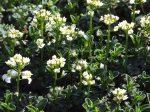 A stoloniferous herbaceous perennial, running rock cress is a member of the mustard family, Brassicaceae, that also includes cabbage, alyssum, and candytuft. It is native to Southern Europe where it grows in mountainous meadows, fields, and disturbed areas. Plants form low dense mats of glossy, bright green persistent foliage with pointed basal leaves that are smooth above and hairy along the veins and margins of the underside. In spring, terminal loose racemes of 3/4″ white cruciform flowers are carried on stems with scattered small ovate leaves. A variety with white-edged leaves, A. procurrens ‘Variegata’, is available. Spreading rock cress is vigorous even in dry poor soil and is suitable for rock or alpine gardens.
A stoloniferous herbaceous perennial, running rock cress is a member of the mustard family, Brassicaceae, that also includes cabbage, alyssum, and candytuft. It is native to Southern Europe where it grows in mountainous meadows, fields, and disturbed areas. Plants form low dense mats of glossy, bright green persistent foliage with pointed basal leaves that are smooth above and hairy along the veins and margins of the underside. In spring, terminal loose racemes of 3/4″ white cruciform flowers are carried on stems with scattered small ovate leaves. A variety with white-edged leaves, A. procurrens ‘Variegata’, is available. Spreading rock cress is vigorous even in dry poor soil and is suitable for rock or alpine gardens.
Type: Herbaceous perennial
Bloom: Terminal loose racemes of 3/4″ white cruciform flowers in spring
Size: 2-8″ H 10-12″ W
Light: Full sun
Soil: Average, dry, well-drained
Hardiness: Zones 4-9
Care: Cut back after flowering to improve form.
Pests and Diseases: Generally healthy but susceptible to white rust and powdery mildew, and root rot is wet soils.
Propagation: Seed, cuttings in spring, division in fall
Companion Plants: Spring bulbs such as crocus and grape hyacinth; moss phlox, alpine pink (Dianthus), spring gentian
Outstanding Selections:
‘Glacier’ (Snow white flowers)
Variegata (white variegated leaves)
Photo Credit: J